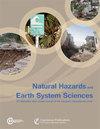利用 5 米洪水模型和气候变化预测绘制当前和未来的洪水暴露图
IF 4.2
2区 地球科学
Q1 GEOSCIENCES, MULTIDISCIPLINARY
引用次数: 0
摘要
摘要地方利益相关者需要有关可能遭受洪灾地区的信息,以管理不断增加的灾害风险。中度和大规模洪水灾害地图通常以较低的空间分辨率绘制,通常只使用一种洪水来源(如河流),而且通常不包括气候变化。本文利用洪水风险科学专家 JBA 风险管理公司绘制的洪水地图,对加拿大温哥华市的洪水风险进行了评估,该地图以 5 米的空间分辨率表示基线风险,并纳入了基于不同温室气体排放情景的气候变化调整值。文章确定了建筑环境中当前和未来的洪水暴露区域,并区分了洪水来源(河流、冲积、风暴潮)和气候变化情景。该案例研究展示了中等分辨率洪水模型在为规划、政策制定和公众教育提供信息方面的实用性。在加拿大所有地区都没有最新的工程或监管地图的情况下,该模型提供了一种机制,以比加拿大全国范围内更高的分辨率识别当前和未来可能的洪水风险。本文章由计算机程序翻译,如有差异,请以英文原文为准。
Mapping current and future flood exposure using a 5 m flood model and climate change projections
Abstract. Local stakeholders need information about areas exposed to potential flooding to manage increasing disaster risk. Moderate- and large-scale flood hazard mapping is often produced at a low spatial resolution, typically using only one source of flooding (e.g., riverine), and it often fails to include climate change. This article assesses flood hazard exposure in the city of Vancouver, Canada, using flood mapping produced by flood risk science experts JBA Risk Management, which represented baseline exposure at 5 m spatial resolution and incorporated climate-change-adjusted values based on different greenhouse gas emission scenarios. The article identifies areas of both current and future flood exposure in the built environment, differentiating between sources of flooding (fluvial, pluvial, storm surge) and climate change scenarios. The case study demonstrates the utility of a flood model with a moderate resolution for informing planning, policy development, and public education. Without recent engineered or regulatory mapping available in all areas across Canada, this model provides a mechanism for identifying possible present and future flood risk at a higher resolution than is available at a Canada-wide coverage.
求助全文
通过发布文献求助,成功后即可免费获取论文全文。
去求助
来源期刊
CiteScore
7.60
自引率
6.50%
发文量
192
审稿时长
3.8 months
期刊介绍:
Natural Hazards and Earth System Sciences (NHESS) is an interdisciplinary and international journal dedicated to the public discussion and open-access publication of high-quality studies and original research on natural hazards and their consequences. Embracing a holistic Earth system science approach, NHESS serves a wide and diverse community of research scientists, practitioners, and decision makers concerned with detection of natural hazards, monitoring and modelling, vulnerability and risk assessment, and the design and implementation of mitigation and adaptation strategies, including economical, societal, and educational aspects.

 求助内容:
求助内容: 应助结果提醒方式:
应助结果提醒方式:


